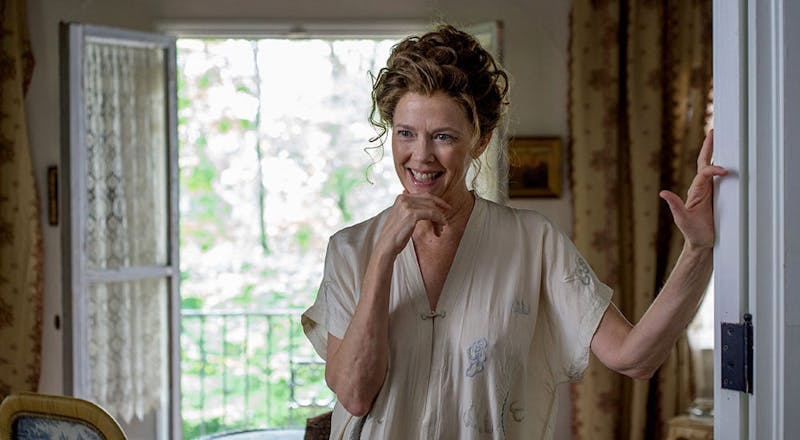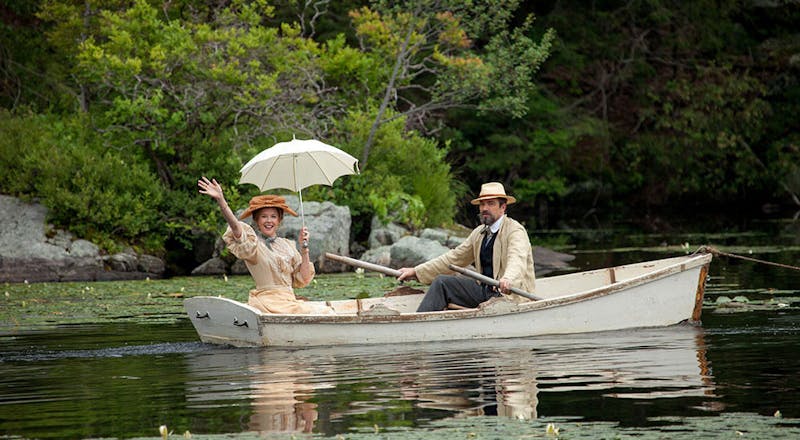There has not been a major film version of Anton Chekhov’s The Seagull for a very long time, and never a great one. Sidney Lumet’s 1968 version, with Vanessa Redgrave as the aspiring actress Nina, missed all the play’s comedy. A mediocre Russian version (with a great score by Alfred Schnittke) was released in 1972. In 1975, John Desmond’s theater production with Blythe Danner and Frank Langella was filmed for movie release, but its pacing drags. Now here comes a new adaptation by Michael Mayer that premiered this week at New York’s Tribeca Film Festival and will enter theaters on May 11. It stars Annette Bening, Corey Stoll, Saoirse Ronan, Billy Howle, and Elisabeth Moss. It is not the full Chekhov monty that only the stage can support. But it is a landmark adaptation that brings out the play’s humor in a way that hasn’t been done before.
The first thing to know about The Seagull is that it is not about a seagull. It is indeed about a symbolic bird, but the Russian for “seagull”—chayka—is the same for a similar bird that frequents fresh water. It’s a mix-up: The Seagull does not take place by the sea, but by a lake whose beauty entrances a group of four central characters: Irina Arkadina (played by Bening), a great actress in the twilight of her career; her famous writer boyfriend Boris Trigorin (Stoll); Nina the teenage beauty (Ronan); and Konstantin, a tortured young playwright (Howle). On the edges is Konstantin’s admirer, Masha (Moss).
The original play is in four acts. It opens at the country estate of Sorin, Irina’s brother. Konstantin, Irina’s son, is staging his first play, an ambitious symbolist work set unfathomably far in the future. Konstantin is in love with Nina, whom he casts in his play as the “soul of the world.” Irina mocks his play, however, unable to be outside the center of attention. Meanwhile, Masha is in love with Konstantin. Another man is in love with Masha. Konstantin loves Nina, but Nina falls for Trigorin. It’s all the fault of the lake, one character observes.
In Act Two, problems start to bubble. Crushed by his mother’s rejection, Konstantin idly shoots a chayka and lays it at Nina’s feet. She’s maddened by the way he communicates in symbols. Trigorin is intrigued by the gesture, however, and makes notes for a future story. In Act Three, Konstantin is revealed to have attempted suicide between acts, but survived. Nina communicates through her own symbol to Trigorin, pointing to a line in his book: “If you ever have need of my life, come and take it.” Irina begs Trigorin not to leave her, and they hurry away back to Moscow. Nina, undeterred, declares her wish to make it as an actress.
Act Four finds the characters two years later, back at the lake house. Masha has given in to her suitor’s siege, and is married with kids. Through gossip we learn that Nina did go to Moscow and win Trigorin’s heart, but their baby died; her career floundered; he went back to Irina. As the group settles down to dinner, we see Konstantin alone in his study. A knock at the door: It’s Nina. She gives an agonizing speech about how she did become that poor dead seagull, before pulling herself together and declaring, “I’m an actress” and making off into the night. As the house guests play bingo, the play comes to a terrible denouement.

Mayer is best known as a theater director. He won a Tony Award in 2006 for his Spring Awakening, and he wrote and directed American Idiot. His first movie was A Home at the End of the World (2004), a slightly difficult but sophisticated film about gay teens, New York life, and HIV/AIDS. As Mayer noted in the question-and-answer session of the screening I attended in New York, he is a theater man. For this movie, he had to reconceive the proscenium—that metaphorical boundary that runs down the front of the stage—as a moving thing, for the camera.
The challenges in adapting The Seagull are many. The play is all talk. Characters speak to themselves when they appear to be speaking to somebody else. Lines of desire and frustration swirl around them in maddening recursion. Love and art are the themes at its core, but they are, in the classic Chekhovian mode, never stated outright. Chekhov is credited with “inventing” subtext. Though this is an overstatement, it is correct that his characters say one thing, feel another, and do some third thing.
In reimagining the proscenium as the camera’s roving eye, Mayer combines two chief moves. He goes deep into the conversations between characters, making heavy use of close-ups, and he stages the whole thing in a lakeside setting of almost obscene beauty. Neither choice is available to stage productions. When Ronan’s face appears for the first time it is a glowing orb that fills the screen. She seems to emit sunshine from inside her white dress. As she acts in Konstantin’s play, oboes fill the air and firelight flickers on the dark forest and the company’s faces.
Later, fireworks crackle against a night so inky and velvet that it hardly seems film. The location (upstate New York, in reality) is perfect, and the movie’s sound brings out all its birdsong and water. Stone steps festooned with flowers fill the screen with rural morning. In the beginning Konstantin has a perfect, vulnerable innocence. In one scene he is making faces in the mirror when he hears his mother cry, “Help!” He whips round to the source of the sound, his funny fish-face turning to shock. It’s a gorgeously simple shot. Konstantin is fresh and clean, his emotions all at the surface.

Ronan makes the transition from ingenue to jaded, wounded seagull effectively. But the best performances are from Bening and Moss. Bening’s Irina is flinty but she has a heart. Bragging about her beauty in every conceivable corner of the property, she provides the comic soul of the film. Moss is also funny as Masha, delivering the play’s famous line, “I’m in mourning for my life,” with a long comic pause at its middle. But her performance of unrequited love is just perfect. Moss has a watery kind of beauty, and here she manages to stay at the brimming point of tears for a whole movie.
The screenplay is by Stephen Karam (Sons of the Prophet, The Humans), and he makes some very bold choices. Most startlingly, he begins the movie with a section from Act Four, putting it before the usual opening of Masha in the forest. I asked Mayer about this move after seeing the film, and he told me that Karam had been haunted by a production seen long ago that had also made this change. The effect is to give the audience a little hint of in medias res characterization, before returning to the exposition-heavy Act One. It works well, here, though it does make watching Act Four confusing, since the repetition is so obvious that it almost feels like the projectionist has switched up the reels.
Begun by Nico Muhly and finished by Anton Sanko—both former assistants to Philip Glass—the score is what anchors The Seagull’s almost overpowering setting to those close-ups. The reed instruments and intermittent piano hammerings from Konstantin have an organic fluidity to them, seeming to beam straight out of the human heart. The music works like interiority, translating the muddled speech of Chekhov’s play into the persistent feeling that is at the core of the work. Tackling Chekhov for the big screen is a huge challenge, since the signature experience of his work is a stage, with a woman on it, talking. By plunging the camera between faces and transforming the setting into a stage that the theater could never match, Mayer pulls it off. The first great Seagull picture is a long overdue and happy occasion.
